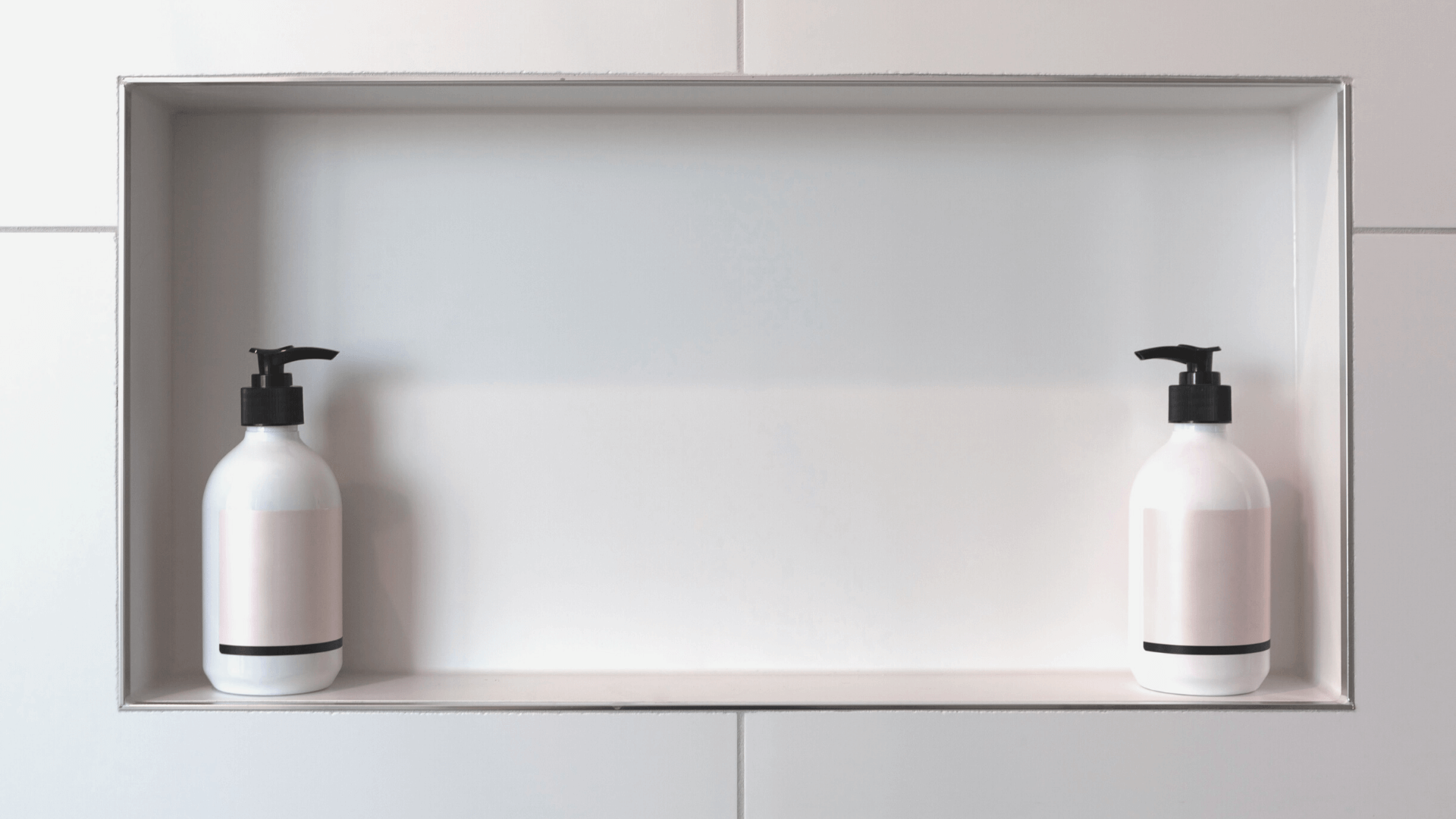Because roughly one in six Americans (48 million people) are sickened by foodborne illnesses every year, a common question is — how to heal your gut after food poisoning?
For me personally, the reason I want to help you address this today is because that bout of food poisoning can also lead to SIBO (small intestinal bacterial overgrowth).
I want to explore this all.
What is Food Poisoning?
Food poisoning is simple: it’s when you become ill after consuming food that has been contaminated by bacteria, viruses, parasites, or toxins.
However, the organisms that pose threats run far and wide.
For example:
- Bacillus cereus (B. cereus food poisoning)
- Clostridium botulinum (Botulism)
- E. coli (Escherichia coli) producing toxin (E. coli infection (common cause of “travelers’ diarrhea”)
- Noroviruses (Variously called viral gastroenteritis, winter diarrhea, acute non- bacterial gastroenteritis, food poisoning, and food infection)
- Salmonella (Salmonellosis)
- Staphylococcus aureus (bacterium)
You can learn all about these + more HERE.
Anyone can get it, but some are more likely to become sick from the contamination.
These populations include:
- Pregnant women
- Those with a weakened immune system
- Older adults (65+)
- Young children (5 and under)
Many foods could be contaminated, but experiencing food poisoning symptoms likely depends on how much and how concentrated the toxin was.
And this is because….
“Foods can get contaminated at any point of processing (inadequate washing or refrigeration), production (incorrectly handled or undercooked), or during serving process (temperature and how it was served),” says Dr. Lee. It’s more common to experience food poisoning after eating in places where meals were prepared for large groups of people, such as school cafeterias, social gatherings, and restaurants, according to the National Institutes of Health. (source)
Common Foods that Cause Food Poisoning
Here is a list of 12 common foods / categories that can cause food poisoning:
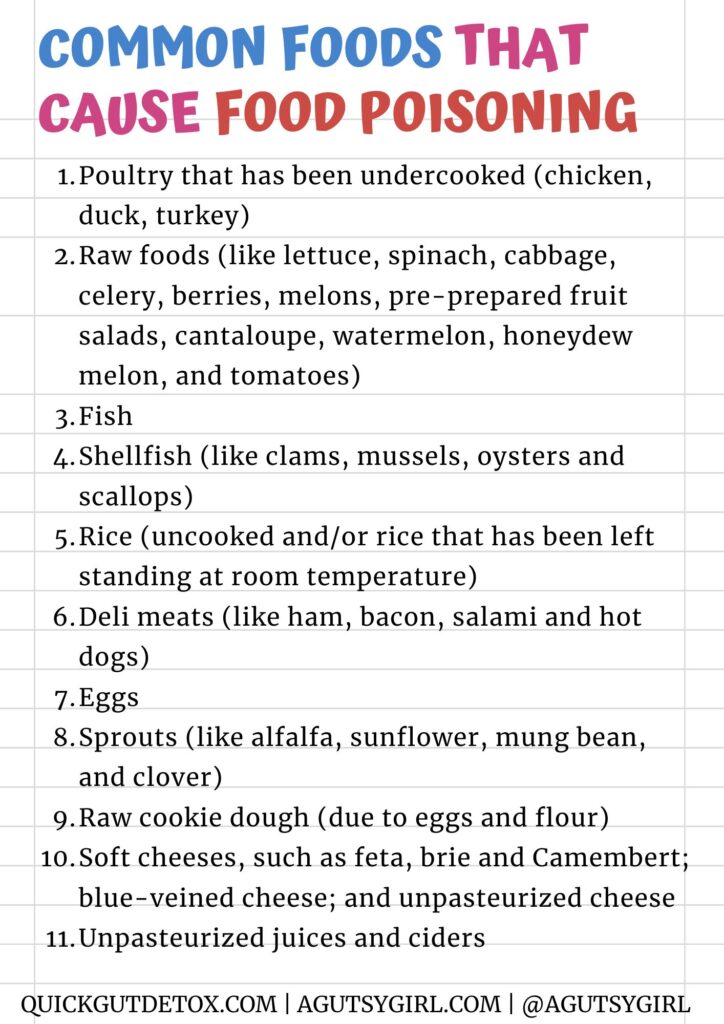
- Poultry that has been undercooked (chicken, duck, turkey)
- Raw foods (like lettuce, spinach, cabbage, celery, berries, melons, pre-prepared fruit salads, cantaloupe, watermelon, honeydew melon, and tomatoes)
- Fish
- Shellfish (like clams, mussels, oysters and scallops)
- Rice (uncooked and/or rice that has been left standing at room temperature)
- Deli meats (like ham, bacon, salami and hot dogs)
- Eggs
- Sprouts (like alfalfa, sunflower, mung bean, and clover)
- Raw cookie dough (due to eggs and flour)
- Soft cheeses, such as feta, brie and Camembert; blue-veined cheese; and unpasteurized cheese
- Unpasteurized juices and ciders
Also, I would not be doing you any favors if I didn’t mention raw dairy, like raw milk, but I still love it and think it has massive gut-health benefits.
What are the Symptoms of Food Poisoning?
It can be challenging to know if you’re experiencing symptoms from food poisoning or the stomach flu, since symptoms tend to overlap.
So, the main thing to watch for is when the symptoms started and how long those symptoms last:
- Stomach flu = 24 – 48 hour incubation period and Food poisoning = 2 – 6 hours after consuming the food
- Food poisoning is typically is shorter in duration than than the stomach flu
Regardless, here is a list of common symptoms if you’ve been poisoned by food:
- Vomiting
- Diarrhea (may include bloody diarrhea)
- Abdominal pain or cramps
- Fever
- Headache
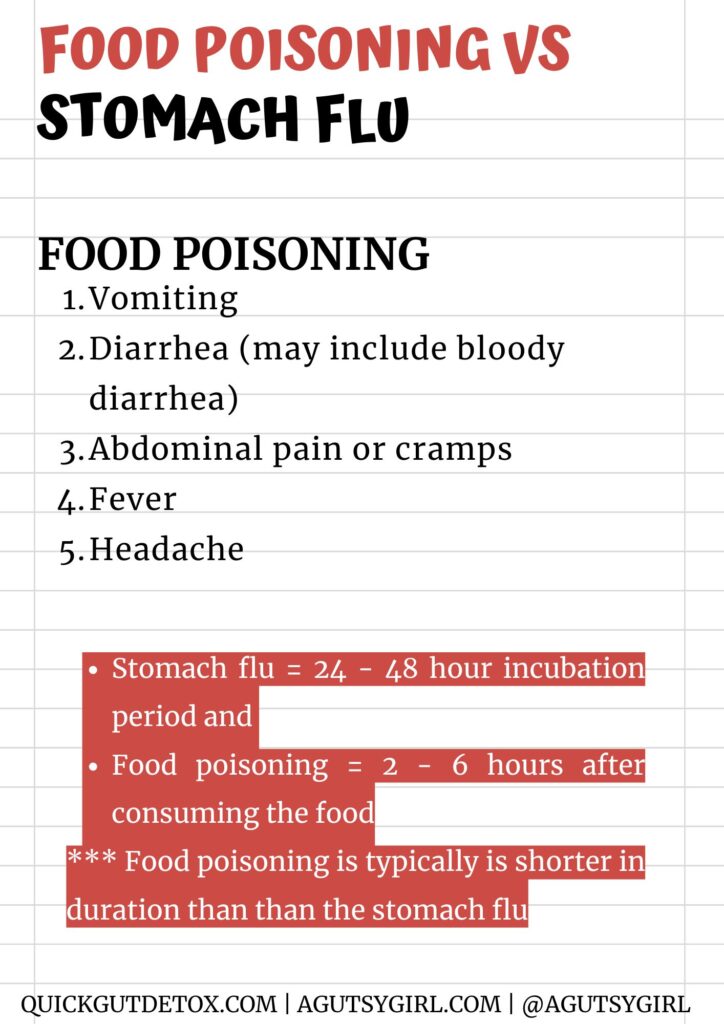
Why Can Food Poisoning Lead to SIBO?
While food poisoning, in and of itself, is miserable – there is another reason I like to talk about it on this gut health website: SIBO.
By the way, knock on wood, I don’t think I’ve ever experienced food poisoning.
Last November, it was possible after eating chicken at a well-known chain restaurant.
A few hours afterwards, I was on the toilet with all the typical signs of food poisoning, but it was just that one time so I can’t be sure.
That being said, no one else had the chicken that night, except me, and no one else got sick. So?????
Anyways, Dr. Karen Wallace claims that food poisoning is the #1 cause of SIBO. She says that it’s because after food poisoning, “your body produces certain antibodies that decrease the motility of your gut.”
Furthermore,
It has been established through several studies that food poisoning or acute gastro-enteritis can be the cause of almost 60% of SIBO and/or IBS cases. Bacteria that cause food poisoning such a salmonella, campylobacter, shigella, e. coli, and possibly viruses and giardia, secrete a toxin called CdtB, which can lead to auto-immunity in the intestinal tract. (source)
Dr. Michael Ruscio adds that,
Food poisoning can initiate an autoimmune process in the gut that damages the Interstitial cells of Cajal (these cells help with motility or the movement of food through the digestive system). When motility is interrupted, it can lead to bacterial overgrowth in the small intestine.
In other words, if you are poisoned from contaminated food, you may be at a higher risk for SIBO due to motility and the MMC (migrating motor complex) being disrupted.
I’ve written about the migrating motor complex at length.
How to Heal Your Gut After Food Poisoning
Click HERE to save this article on how to heal your gut after food poisoning for later.
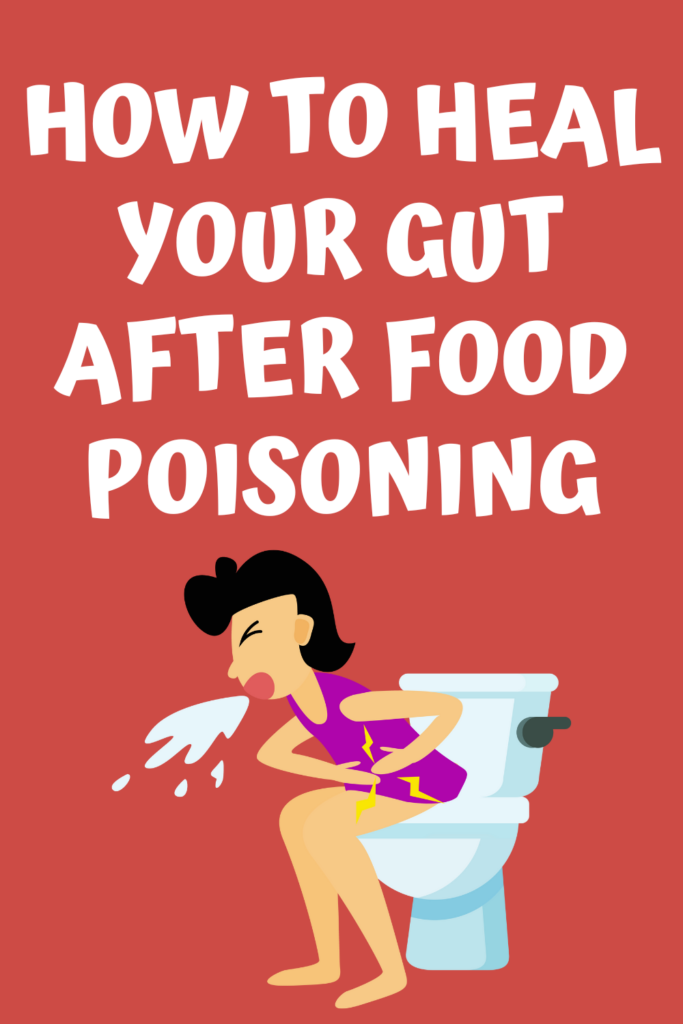
So, let’s say it’s not a stomach bug, but instead you were in fact poisoned by food.
Here’s how to heal your gut after food poisoning – the basics…..
Rest
You’ll need to rest.
No matter what, food poisoning or not, resting is one of the best ways to heal your gut.
There is a reason this is so popular: rest and digest.
Re-Hydrate
Of course you should consume water and drink plenty of fluids.
But you also need electrolyte solutions for avoiding severe dehydration.
In addition to helping with the nervous system, electrolytes also have many other functions across the body.
These include:
- establishing muscle function- muscle contractions and relaxation
- helping with the concentration and balance of water
- establishing brain function
- removing waste inside of cells
- establishing heart function
And because this is a GUT HEALTH website, I’m not going to recommend the standard sports drinks like Gatorade.
Here are 5 alternatives to Gatorade:
- “Homemade Gatorade”
- LMNT
- Nuun
- Low-Fat Chocolate Milk (this would be my last choice for food poisoning recovery, since it’s dairy)
- Coconut Water
You can learn about all 5 of these in great detail HERE.
Note for children: you will almost always see Pedialyte® listed in the top rehydration solutions. I would never give this to my children. Here are the ingredients in the Pedialyte Powder Packs (grape flavor):
Dextrose, Citric Acid, Potassium Citrate, Salt, Sodium Citrate. Less than 2% of: Natural and Artificial Flavor, Beet Powder Color, Calcium Silicate, Acesulfame Potassium, Sucralose, and Blue 1.
In one pack, there is 370 mg of potassium and 570 mg of chloride.
So the goal would be to get that somewhere else without all the extra ingredients.
You can make your own natural Pedialyte, try the Cure Hydration (for kids) or even just use 1/2 pack of the LMNT (my kids love it)!
Choose Your Foods Carefully
Whenever you’re following a general gut health plan, you must choose foods wisely and not follow the usual diet consisting of the Standard American Diet foods.
But especially now.
Avoid:
- caffeine
- alcohol
- a lot of spices, spicy foods, and seasonings (which I DON’T recommend for overall gut health)
- fried and fatty foods
- extra sugar
- raw vegetables + raw fruits
- dairy products
Consume:
Simple and bland foods.
(Note: many sources will tell you the BRAT diet (bananas, applesauce, rice, toast) at a time like this. I’m not a huge fan of that for various reasons. Yes, I still think you can do them, but I wouldn’t only do that.)
Instead, consider:
- bone broth (make your own bone broth OR grab it from Kettle + Fire)
- garlic (you can even infuse this into your bone broth; garlic has strong antiviral, antibacterial, and antifungal properties)
- cooked (soft) carrots
- plain crackers (choose something high quality; I love the Simple Mills Fine Ground Sea Salt Almond Flour Crackers, which also contain sodium to help replace electrolytes)
- DIY coconut yogurt
- plain oatmeal and/or quinoa
- homemade Jell-O
You don’t need a huge food list; just need to be cognizant of the simple foods.
Probiotics
Your healthcare provider (or not!) might suggest taking a probiotic.
The NIH states,
Studies suggest that some probiotics may help shorten a bout of diarrhea. Researchers are still studying the use of probiotics to treat food poisoning.
Here is some fantastic information from Just Thrive Health on the best probiotic strains for diarrhea:
When it comes to quickly rebalancing the gut microbiome and stopping diarrhea, some strains of probiotic bacteria work more effectively than others.
Among the best choices? Spore probiotics, which – because of their protective outer “shell” – easily survive the harsh environment of the digestive system, actually arriving alive to your gut, ready to fight against the bad bacteria.
When you’re struggling with diarrhea – whether it’s acute, chronic, or recurrent – these are the four spore probiotics you want on your side:
Bacillus coagulans has been shown to:
- improve diarrhea symptoms and quality of life
- decrease gas, bloating, and abdominal discomfort
- reduce GI discomfort, calm gut inflammation, and boost mood
- decrease diarrhea symptoms from a wide variety of causes, including antibiotics, IBS, and food poisoning
Bacillus clausii safely and effectively helps ease diarrhea for any age person.
- One new clinical trial showed that clausii safely improved stool consistency, reduced frequency, and cleared up diarrhea more quickly in children aged 6 months to 5 years old.
- A recent meta-analysis of six clinical trials found that clausii reduced stool frequency and stopped diarrhea sooner than other interventions.
- clausii works just as effectively in adults to substantially reduce diarrhea symptoms, frequency, and duration
Bacillus subtilis HU58 produces more than two dozen natural antibiotic compounds that can kill off pathogenic bacteria, including E. coli and Salmonella, two common causes of food poisoning. Plus, B. subtilis effectively fights diarrhea in animals and people.
Bacillus indicus HU36 produces powerful antioxidants right in your GI tract – where you body can best use them – that can stop the toxic by-products of pathogenic bacteria from doing damage.
Our entire family takes these probiotics. If you want to try either / both the capsule or gummies, you can use code AGUTSYGIRL at checkout to save 15%.

Avoiding SIBO After Food Poisoning
Now, as promised here are the top 6 things to pay attention to after becoming food poisoned to avoid SIBO…….and honestly, the main thing to focus on will be motility.
Click HERE to save these things for later.

(Actually) Rest and Digest
Pay attention to when you are consuming food. Don’t just eat haphazardly all day long aka. snacking.
During the day, I recommend meal spacing.
And at night, I recommend fasting. This does not have to be a traditional intermittent fasting schedule where you only eat 8 hours of the day and fast for 16 hours.
Instead, you can make it sane and simply fast for 12 – 14 hours nightly.
Even though I healed my SIBO, I STILL practice both meal spacing and fasting.
This is what it looks like.
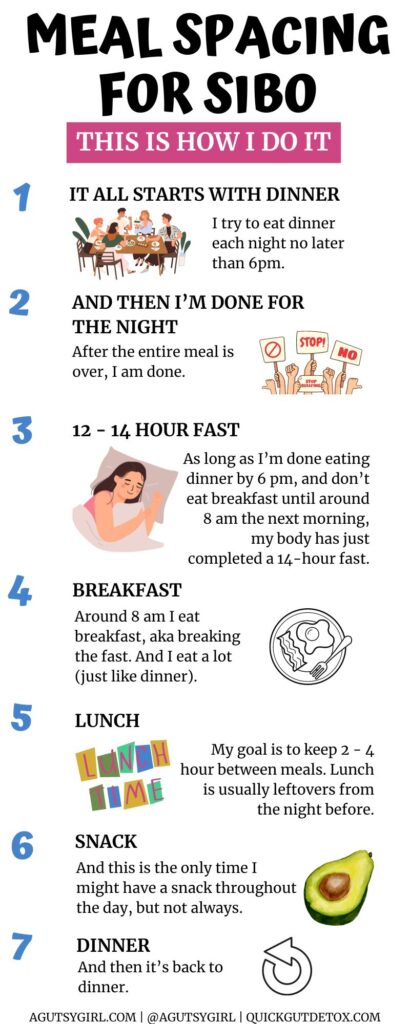
Food Choices
This one is far too complicated to cover in this post.
But I do have an entire guide called Reasonable SIBO where you can see all about food that’s recommended if you’re wanting to follow the low-FODMAP diet.
HOWEVER, even though raw fruits should be avoided following food poisoning, there is one that I might consider; kiwifruit.
Clinical studies in a range of adult populations consistently indicate that kiwifruit are a highly effective dietary option to promote laxation.
This, together with emerging evidence for the putative effects of kiwifruit in beneficially promoting gastric emptying and digesta mixing, suggests that kiwifruit are physiologically active throughout the gastrointestinal tract. (source)
DO caution if you still have diarrhea, though. I’m talking about food choices afterwards to ensure you don’t get SIBO.
Be More Selective with Fat and Meat
Both fats and meat like ground beef can slow down the digestive process.
Ways to help with this include: naturally breaking down fat, using HCl, accompany heavier meals with digestive enzymes, and/or eating the fats and meats with easy-to-digest foods.
I have done all of this at various times!
Note: please do not believe that fat and meat are to be vilified. For most, they are not the villain.
Consider taking a Prokinetic
A prokinetic is something that stimulates movement or gastrointestinal motility.
Prokinetics I have use(d) and love include: LDN (low dose naltrexone), ginger, magnesium, Iberogast, and MotiliPro.
I have put together an entire list of both pharmaceutical and non-pharmaceutical prokinetic options HERE.
Hone in on the Vagus Nerve
Here are just 4 ways the Vagus Nerve and digestion are connected:
- The vagus nerve tells the stomach to churn the food within it, as well as to produce stomach acid that’s necessary for digesting that food and a number of other things. That’s why a damaged or under-active vagus nerve often results in low stomach acid levels and low enzyme production. In turn, this means digestion is ineffective. (source)
- The Cleveland Clinic reports, ” Vagus nerve damage can lead to gastroparesis, food not moving into your intestines.”
- This research indicates, “A significant, and growing, body of literature supports the actions of gastrointestinal luminal microorganisms to modulate gut-brain signaling via vagal afferents, the so-called microbiota-gut-brain axis. While gut microbiota might normally be expected to activate vagal afferents directly only under conditions where intestinal permeability is compromised (e.g. following inflammation or stress), luminal bacteria may activate vagal afferents indirectly, subsequent to stimulation and release of neuroactive mediators from enteroendocrine cells or gut associated lymphoid tissue (GALT). (source)
- Furthermore, the research study in #3 also states, “The GI tract receives the majority of the vagal efferent nerve fibers and harbors the most immune cells in the body.”
This is a HUGE component for which you might be overlooking.
I have an entire article all about Vagus Nerve Stimulation HERE.
Consider Specific Lifestyle CHANGES
Addressing motility can be with simple things you’re overlooking:
- Chew your food. Did you know, you should chew each bite of food 30-40 times prior to swallowing? The more your teeth grind food down, the less work (= time) your digestive tract has to do.
- Drink enough water (this is critical for obtaining the daily bowel movement) but don’t drink water with meals. While you should drink more water in general for healthy digestion, drinking water with meals can dilute digestive juices and digestive enzymes and interfere with overall digestion.
- Get regular exercise (but not at super high intensity levels) + consider physical activity after meals
- Cut the alcohol! The NIH states that, ‘Chronic alcohol intake leads to intestinal inflammation, including altering intestinal microbiota composition and function, increasing intestinal permeability, and affecting the intestinal immune homeostasis.’ There are literally ZERO great reasons for drinking alcohol, even though societal standards have us believing otherwise. For the purposes of this article, high alcohol concentrations (i.e., above 15 percent) appear to inhibit gastric motility.
- Use a squatting stool! You’ve likely heard of the Squatty Potty, yes? Well, I have a tutorial on how to make your own HERE. I swear by using one!
Ask Your Health Care Provider About Other Supplements for Motility
Some of these can and oftentimes do include:
- Digestive enzymes
- Magnesium
- Aloe vera
- Ginger
- Peppermint oil
- Apple cider vinegar
- Probiotics
- Iberogast
- HCl
- Dysbiocide
- Vitamin C
You can learn more about #1 – 9 HERE.
Learn more about Dysbiocide HERE.
And learn more about Vitamin C HERE.
Wrap Up
Getting food poisoning (in most cases) isn’t the end of the world.
In a couple of days, you should bounce back. (If not, be sure to seek medical attention).
The upset stomach, stomach pain, and diarrhea should subside.
However, do watch for SIBO symptoms, and anything you’re noticing after being exposed to food poisoning.
While I haven’t had an extreme case of food poisoning, I DID have an advanced case of SIBO that took forever to get rid of (I relapsed multiple times because I didn’t understand the importance of motility).
And believe me when I say that’s it’s the last thing you want or need in your life.
Any questions?! Let me know in the comments below.
If you liked this article on how to heal your gut after food poisoning, you might also enjoy:
- Gut Bacteria Die Off Symptoms
- Probiotic Foods vs Prebiotic Foods
- Refrigerated Probiotics vs Non Refrigerated Probiotic Supplements
Xox,
SKH
🤰 bloating be gone! weight loss through optimal gut health for women
💃ʜᴇᴀʟ ʏᴏᴜʀ ɢᴜᴛ. ʜᴇᴀʟ ʏᴏᴜʀ ʟɪfe.
🫶🏻 founder gutbyome.com




![Things You May Not Have Considered for Healing SIBO [2017 SIBO Status Update]](https://agutsygirl.com/wp-content/uploads/2020/04/home-office-featured-agutsygirl.com_.png)
